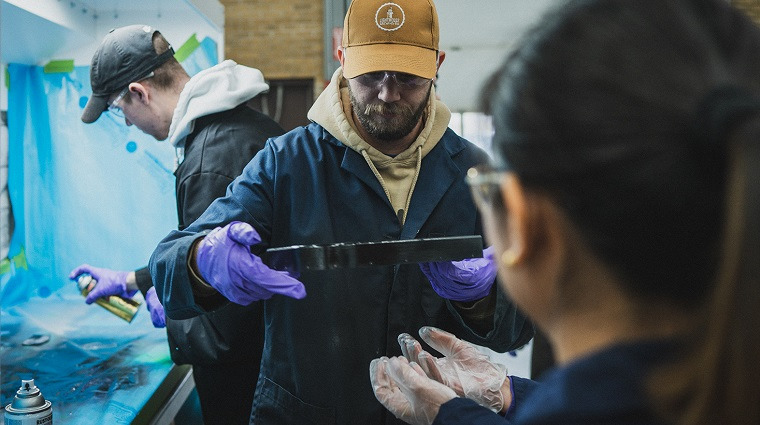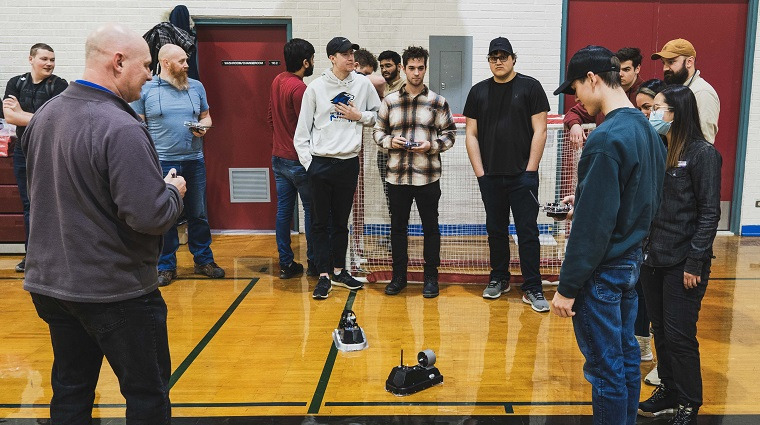
Work that feels like play. Often cited as a recipe for career satisfaction, it’s a fitting description for a recent end of term project undertaken by students in Saskatchewan Polytechnic’s Design Manufacturing Engineering Technician (DMET) program. Twelve students in the program’s production management class wrapped up their term by creating small, working hovercrafts, then got the chance to test them in the gymnasium on the Saskatoon main campus.
Leon Lipoth, the instructor who taught the class, explains that the project is an intensive six-week group assignment that lets students put into practice much of their learning from previous terms, including programming, basic electronics and use of specialized equipment such as a waterjet and 3D printer.
This year’s class was divided into three teams of four students who worked together to build the hovercrafts as team green, team blue and team red. The groups chose finishes for their final products and some came up with add-on capability features that made each craft unique.
The two-part project began with the building of the hovercraft’s remote control, which comes as a printed circuit board with roughly 300 components the students need to solder into place. Key to the controller’s function is a tiny component called an Arduino Nano. “Arduinos are a maker’s choice for doing physical computing,” says Lipoth. “They’re meant for building things that take actions based on their environment—robots, temperature sensors, moisture sensors—any kind of projects that involve sensing real-world parameters. Our students learn how to program them in their first year in a mechatronics class and this project allows them to put that knowledge to actual use.”
Besides the Arduino Nano, the remote control has an accelerometer, which lets the user determine axes and movement to transmit to the Arduino. There are also two joysticks, two potentiometers, toggle switches and push buttons. “The first part of the journey is to build the board up,” explains Lipoth, who designed the board and populated it with components for the students to work on.
The hovercraft itself, which is about the size of a shoe box, is built from components the students produce in Sask Polytech’s Research, Additive Manufacturing and Prototyping (RAMP) lab. A small brushless motor sits inside the craft’s shell at the back, and the front has a propellor to give it thrust to move forward. A similar motor and propellor gives it thrust that pushes air down into a flexible apron underneath, which is what allows the hovercraft to ride on a cushion of air. The basic design for the hovercraft is canned, but students create the shell using a 3D printer then have to come up with their own design for a harness to run the wires and make it all fit along with the battery.
For a project to pass muster, it must meet the minimum expectation that the hovercraft works and that the remote control can be used to operate it. “Building the hovercraft and making it their own is fun, but the project is really about constructing and programming the remote control, which populates the board and allows you to move the hovercraft,” says Lipoth.
The instructor added an optional extra challenge to the project to give students who complete their remote control quickly higher-level learning opportunities—and more fun. “I give them a design I know will work, but I tell them to build it and then add some kind of custom function or feature. Some groups have time to add more than one and it’s exciting to see what they come up with.”
“This was the first bigger group project we’ve done, and our first chance to use some creative license, too” says Jack Sanderson, one of the students on team red. “My group collaborated on ideas and worked well together with our different skills sets. I have the strongest programming skills so I took the lead on that. We all worked together to decide what features to add to our craft. My group added an LCD license plate and an ultrasonic sensor to help it avoid objects it gets close to, which is something we never learned in class. We had enough knowledge from a previous class in the program to know how to figure these things out, so we were able to take the ideas and run with them.”
“The best part of the additions students make to their hovercrafts is that they learn on the job,” agrees Lipoth. “They’ve got the basics but they need to go a step further to figure out how to make a new component or function work. It’s an exciting way to learn and the students are highly motivated. I never taught them how to use a liquid crystal display in class as part of their curriculum, for example. Instead, I let them know what components were available and where to find examples and they taught themselves. You engage them on their own to figure things out.”
All the controls on the remote aren’t required to operate the hovercraft, which leaves a second joystick, potentiometer, accelerometer and toggle switches that the students can choose to program to control additional functions. Team green embedded RGB LED lights in the bottom so they could light up the apron with different colours using a radio signal, chosen by one of the potentiometers on the remote control. That group also made the accelerometer drive the hovercraft so tilting the remote would control how it moved.
Ann Quimado, a team green student with strong time and project management skills, says her team chose features they felt were feasible considering the timeline. “We wanted to make our hovercraft look better, and our lead programmer, Jackson, thought an aesthetic feature like LED lights was something we could accomplish.”
“Our groups were well balanced in terms of strengths,” adds Quimado. “We had a strong programmer, which is an area I’m not yet as comfortable with, and a student who had previous experience with manufacturing, and also someone who was good at assembly and electronics. We were a diverse group and that worked well.”
Early this January, the twelve students and Lipoth gathered in the gymnasium on the Saskatoon main campus to launch their finished hovercrafts as a final demonstration, inviting guests to see the hovercrafts in action. Two groups had used the same radio frequency and since the controllers’ range is about one kilometre it was quickly determined that their crafts couldn’t run at the same time. Speeds get up to about the pace of a run, and parts can come flying off if they aren’t attached properly. “I initially envisioned a race, but didn’t want it to end up being a crash-up derby,” says Lipoth. “The day became more of a demonstration, but it was still exciting.”
All of the remote controls and hovercrafts worked, but team blue had the satisfaction of being the only team to build a hovercraft that operated without a hitch. Tyson Church, who was lead coder for the team says his group had hoped to build and additional feature that would help stabilize their craft but ended up spending their time getting everything to operate correctly. “It was satisfying to see something work that I helped to code,” he says.
Students will soon be putting their skills to use in the real world in a variety of sectors including agriculture, mining, technology and more. “Employers in this field currently can’t find enough people to hire. We see companies offering students jobs months before graduation,” says Lipoth. “DMET students are well set up for a career in engineering technology.”
Church, who came to the DMET program right out of high school isn’t sure where he wants to work after graduating but says applied research opportunities are of interest to him. “I considered going the university engineering degree route but I was more interested in hands-on engineering. I enjoyed this project because it really was start-to-finish—everything from design, to manufacturing to programming. Applied research could give me a similar chance to see things through from concept to product.”
As Lipoth reviewed and graded the hovercrafts he reflected on the term project. “The students clearly enjoyed this. I thought the whole project was fun, too—I enjoyed building the board and walking them through it. I always try to make in-class experiences have some fun component. When learning is enjoyable it’s more rewarding.”
For more information about Sask Polytech’s Design Engineering Manufacturing Technology program, visit our website: Design and Manufacturing Engineering Technology - Diploma (saskpolytech.ca)

Published February 2023.

